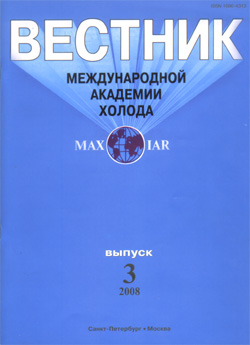
Changes of beef protein fraction in "freezing–storage–heat treatment" cycle

Annotation
Samples of Musculus semitendinosus beef produced in Leningrad region were used as a material for research. The ability of trypsin and chymotrypsin to attack fibrillar and sarcoplasmic protein fractions, expressed in terms of tyrosine units released by hydrolysis under standard conditions per mg of protein nitrogen, was studied to determine the change in meat proteins availability to proteolytic enzymes. The influence of meat autolysis state (fresh-killed and ripe), freezing and frozen storage at –29 ± 1 оC for 7 months, and heat treatment on the availability of two beef protein fractions for enzymes was studied in their extracts. It is shown that the nature of changes in substrate availability for enzymes is identical for the two groups of proteins and depends on the condition of the meat before freezing. It was determined that fibrillar proteins are hydrolyzed by trypsin and chymotrypsin in a greater degree. Denaturation processes during freezing and storage of fresh-killed and ripe meat at –29 ± 1 оC do not adversely affect the overall digestibility of meat proteins. The information obtained is important for justifying the biological value of meat and meat products after freezing and thermal processing, the coefficient of digestibility being taken into account. Data on the effect of enzymes on proteins after refrigeration and heat treatment is also of interest if subsequent biotechnological modification of meat takes place.
Keywords
Постоянный URL
Articles in current issue
- Prevention of Diabetes through use of Hypoglycemic Chinese Herbs
- New method of two-stage air and water vaporizing rotational cooling of food being preserved in glass container
- Technological aspects of food soy dresser preservation
- Antioxidant activity of fruit raw material during freezing and vacuum dehydration
- Transformation's kinetic reaction of organic acids during the cold storage of Tangor (Ortanique)
- Different applications of cylinders with cryogenic filling*
- Design of systems of drainage of air of refrigerators
- Study of short low temperature range heat pipes. Part 1. Experimental and numerical studies
- The dimensionless characteristics of centrifugal compressor stage axial-radial impeller
- Reserving components of the blood and hematopoietic cells using low temperatures: current status and prospects for implementation in the interests of victims in emergency situations
- Experimental research on thermoelectric system for thermal impact on particular zones of human arm
- The thermal conductivity measurements at very low density of 1.1.1.2–Tetrafluoroethane (HFC-134а)
- Thermo-induced variation of pressure in cryogenic systems
- Efficiency of quadratic turbulence models application for separated flows simulation in technological aggregates
- The second virial coefficient of difluoromethane
